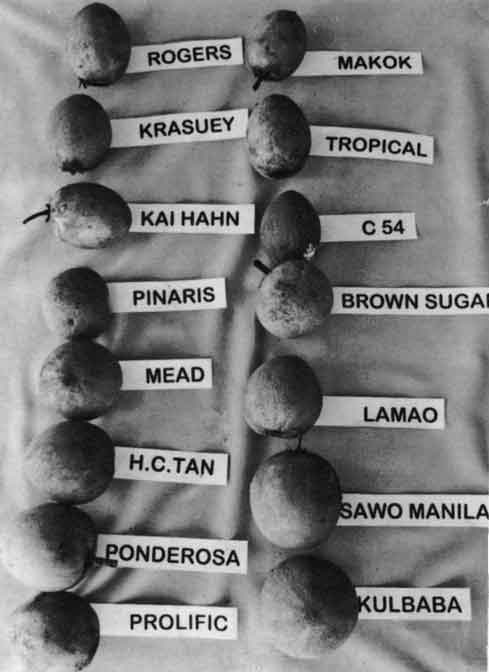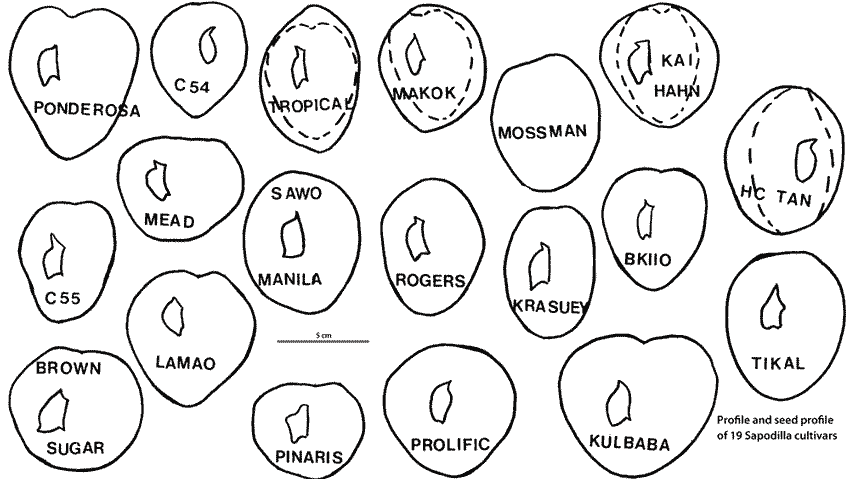From the Archives
of the Rare Fruit Council of Australia
by A.
Oram
 Sapodilla
Sapodilla
Scientific
names: Achras sapote, Manilkara zapota
Family:
Sapotaceae
Common name:
Sapodilla, Chico, Sapota, Chiku, Dilly.
Native to:
Central America and West Indies.
Habit of
growth: Upright, pyramidal tree, long lived, slow growing.
Height:
5 - 25 m.
Leaves:
Glossy, alternate and spirally clustered at the tips.
Flowers:
Inconspicuous, small white flowers, borne singly in axils of leaves.
Several flushes per year.
Fruit:
Round to egg-shaped fruit, vary from 2 - 4 inches in diameter. The skin
is thin, brown and scruffy, the flesh is light brown to reddish brown.
The flesh can be smooth or granulation texture. The flesh is sweet,
juicy and fragrant. The seeds are black, flat, hard, shiny, with a
hook. [Dangerous if swallowed]. They vary in number from zero to twelve
and are easily removed from the flesh.

Fig. 1
15 Sapodilla varieties.
Climate:
Young trees can be killed or injured at temperatures of 30-32°F
[-1-0°C] large trees can withstand temperatures of 26-28°F
[-3.33 to -2.2°C]. Protect young trees from the cold by wrapping
stems with hessian. The sapodilla can stand humid or relatively dry
atmospheres. It is quite resistant to strong winds. The tree is highly
drought-resistant and can stand salt spray and quite a degree of soil
salinity [ECE 14.20].
Soils:
Best in well-drained soils but adapts to most soils. [6-7 pH].
Pests:
Scale, peach moths, mealy bugs, spotting bug.
Uses:
Eaten fresh, made into sherbets, ice cream, jam, syrup, dilly rice and
custards. In Philippines it is fermented into vinegar. The tree was
tapped for latex, which was used in the making of chewing gum. It is
tapped every 3 years and yields 2.7 to 3.6 kgs of gum.
Flowering
time: November to February.
Harvest:
September to November.
Maturity is difficult to determine. Some methods are:
1.
Scratching a small part of the skin to see underlaying flesh. If the
underlying flesh is green it is still immature, but if it is a reddish
colour it can be picked and it will ripen in a few days.
2. Wait until a few of the fruit fall and then pick the largest fruit
from the tree.
3. On some varieties, the needle at the end of the fruit will drop off
when mature.
4.
If you have time, you can also feel every fruit to see if they are
slightly soft to touch. It needs to be done daily or they drop and are
ruined with the fall.
This is perhaps the most difficult problem
with the sapodilla. I like to scratch the skin of the fruit and then
pick the biggest fruit. They ripen in 3-4 days. The next problem is
when to eat them. They have to be soft to touch. The longer they are
left to soften, the stronger and sweeter the flavour and the flesh
colour becomes darker. The flavour is enhanced by putting the fruit in
the fridge to cool before eating. The skin can be eaten and in fact is
richer in nutritive value than the pulp. I haven't eaten them this way
yet, but I think I would like to wash them to remove the scruff layer
of the fruit, before eating. The fruits are a good source of calcium,
phosphorus and iron.
The flowering in sapodilla is much like the
avocado and comes in distinct phases. Piatos and Knight [1975] found
that the sapodilla is self-incompatible, requiring cross pollination.
There is also a problem with non-viability and deficiency of pollen.
Some single trees may only produce a few fruit a year.
I
tried to do a comparison on the different fruits. It was difficult to
do so as they tasted and looked different at different maturity times.
The flesh became darker if I left it a few days longer and the taste
was stronger as well. Putting the flesh in the fridge to cool also made
the fruit taste different, in fact better. Another factor which
surprised me was that some fruit changed shape from year to year.
Cultivars H.C. Tan and Tropical were two varieties that changed shape.
I have read that in India some cultivars have round and elliptical
fruits on the same tree at the same time.
| Name |
Origin |
Seeds |
Av-Wt. |
Skin |
Flesh |
Taste
and Texture |
| Markok |
Thailand |
4 |
70-100 gms |
light brown |
mid-brown |
sweet, juicy, slightly grainy |
| Rodgers |
|
2 |
75-100 gms |
light brown |
light brown |
sweet, juicy, slightly
grainy, bland [immature fruit] |
| C54 |
Malaysia |
3
|
100 gms |
mid-brown |
light brown |
firm, sweet, juicy, slightly
grainy |
| Kai
Hahn |
Thailand |
6
|
50-100gms |
mid-brown |
mid-brown |
pearish, strong, juicy,
sweet, grainy |
| Krasuey |
Thailand |
2-4 |
75-100 gms |
light brown |
mid-brown |
juicy, very sweet, syrupy,
grainy |
| Tropical |
Singapore |
1 |
75-100 gms |
light brown |
mid-brown |
juicy, very sweet |
| Tikal |
Florida |
2 |
100 gms |
light brown |
light brown |
semi-sweet, juicy, smooth |
| Pinaris |
Philippines |
5 |
100-120 gms |
mid-brown |
mid-brown |
juicy, bland to
mid-sweet,slightly grainy |
| Brown
Sugar |
Florida |
7 |
100-150 gms |
light white brownskin |
light brown |
juicy, mid-sweet, grainy |
| H.C.Tan |
Singapore |
2-3 |
125-150 gms |
mid-dark brown |
light brown |
bland smooth |
| Lamao |
Lamao |
3 |
150
gms |
light brown |
light brown |
sweet, juicy, strong flavour,
smooth |
| Mead |
Florida |
7 |
150 gm |
light brown |
light brown |
juicy, sweet, slightly grainy |
| Sawo
Manila |
Indonesia |
2-4 |
100-150 gms |
light brown |
light to dark brown |
juicy, sweet, slightly grainy |
| Ponderosa |
Philippines |
5 |
175-250 gms |
light brown |
light to mid-brown |
sweet, juicy, smooth, really
nice |
| Prolific |
Florida |
3 |
200-250 gms |
light brown |
light brown |
firm, pearish, sweet,
slightly grainy |
| Kulbaba |
|
4 |
250 gms |
light brown |
light brown |
smooth,sweet, juicy |
| Mossman |
Australia |
6-8 |
75-125 gms |
dark brown |
light brown |
sweet, juicy |
| C55 |
|
|
75 gms |
light brown |
light brown |
sweet, juicy |
| B.K.110
|
|
|
50-100 gms |
mid-brown |
light brown |
juicy, sweet, slightly grainy |

Fig. 2 
Profile and seed profile of 19 Sapodilla
cultivars
|
|



